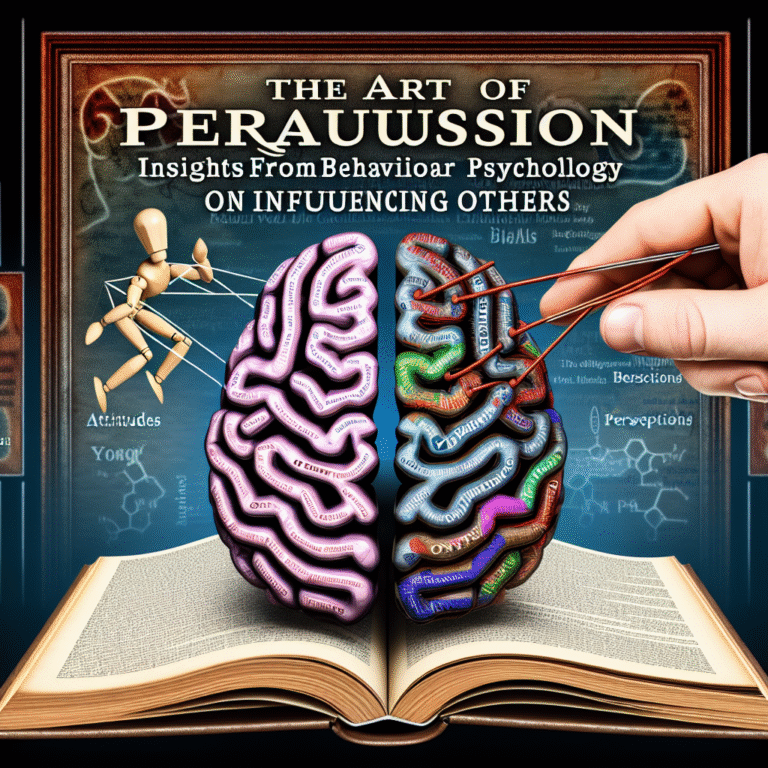
Building Better Habits: Proven Strategies from Behavioral Psychology You Can Implement Today
Introduction
Imagine waking up each morning brimming with energy, excitement, and motivation to tackle the day ahead. You spring out of bed, ready to dive into your goals, whether that’s hitting the gym, eating healthier, or simply being more productive at work. Sounds idyllic, right? But for many, these scenarios remain just that—dreams. The cornerstone of achieving such transformative outcomes is understanding and implementing subtle but effective strategies from behavioral psychology. In this article, we’ll explore Building Better Habits: Strategies from Behavioral Psychology You Can Implement Today to create lasting change in your life.
Why Habits Matter
Habits are the invisible drivers of our daily lives. They shape our routines, influence our decisions, and dictate our success. According to research by Duke University, about 40% of our daily actions are driven by habits, meaning that our lives reflect our established routines more than they reflect conscious decisions. Understanding how to build better habits can lead to improved health, enhanced productivity, and greater happiness. The journey to Building Better Habits: Strategies from Behavioral Psychology You Can Implement Today begins with understanding how habits form and how they can be modified.
Understanding the Habit Loop
One of the foundational concepts in behavioral psychology is the habit loop, which consists of three components: cue, routine, and reward.
Cue: This is the trigger that initiates the habit — it could be a specific time of day, an emotional state, or an environmental cue.
Routine: This is the behavior you perform in response to the cue. For example, when you feel stressed, your routine might be reaching for a sugary snack.
- Reward: This is the benefit you gain from completing the routine, which reinforces the habit and makes it more likely to recur.
Understanding this loop is vital for Building Better Habits: Strategies from Behavioral Psychology You Can Implement Today. When you know the loop, you can dissect your habits and start making meaningful changes.
Case Study: The Habit Loop in Action
A study published in the journal Experimental and Clinical Psychopharmacology examined the habit loops in individuals trying to quit smoking. Researchers discovered that identifying cues (like seeing a cigarette) allowed participants to develop alternative routines (like going for a walk) to replace the smoking habit. By focusing on the cue and changing their routine, participants significantly improved their chances of quitting.
Analysis
This case study illustrates the effectiveness of addressing the components of the habit loop rather than solely relying on willpower. By recognizing and modifying cues and routines, you can successfully create healthier habits.
Strategies for Building Better Habits
1. Start Small: The Two-Minute Rule
The Two-Minute Rule, coined by productivity experts, suggests that any new habit should take less than two minutes to initiate. For example, if you want to start reading more, begin by reading one page a day. This small commitment often leads to longer sessions over time, seamlessly integrating the behavior into your routine.
Implementation Tip:
Set a timer for two minutes and engage in your new habit. This makes it feel more manageable and less daunting.
2. Habit Stacking: Link New and Existing Habits
Habit stacking is a technique that involves linking a new behavior to an existing one. This is based on the principle of anchoring, where you’ll perform the new habit immediately after the existing one.
Example: After your morning coffee (existing habit), you meditate for two minutes (new habit).
Implementation Tip:
Make a list of your existing habits and identify where you can attach new ones.
3. Environmental Design: Shape Your Surroundings
Your environment significantly influences your habits. Behavioral psychologists emphasize the importance of structuring your environment to favor good habits and discourage bad ones.
Example: If you want to eat healthier, keep fruits visible on your kitchen counter instead of hiding chips in the pantry.
Implementation Tip:
Conduct a “clutter audit” of your environment and remove distractions or temptations related to your undesirable habits.
4. Use Positive Reinforcement
Behavioral psychology underscores the importance of rewards in reinforcing habits. When you complete your habit, no matter how small, reward yourself to create a positive association.
Example: After a workout, treat yourself to a relaxing bath or a favorite snack (within reason).
Implementation Tip:
Keep a habit tracker, and when you reach daily or weekly goals, indulge in a larger reward.
5. Accountability Partners: Leverage Social Influence
Having an accountability partner can exponentially improve your chances of sticking to new habits. This applies social pressure and support, making it easier to maintain commitment.
Implementation Tip:
Share your goals with a friend or join a community group where you can share progress and setbacks.
6. Mindful Awareness: Reflect on Your Habits
Mindfulness involves being present and consciously aware of your habits without judgment. By practicing mindfulness, you can better understand when and why you engage in certain behaviors.
Implementation Tip:
Take a few moments each week to reflect on your habits. Journal your thoughts and feelings about your progress and challenges.
Case Study: A Community Approach
A research project by the University of Pennsylvania explored the role of accountability in changing health behaviors among college students. Students who participated in groups with shared health goals showed a 25% increase in their adherence to exercise programs compared to those who worked individually.
Analysis
This study highlights the power of social influence as a strategy for Building Better Habits: Strategies from Behavioral Psychology You Can Implement Today. When individuals are part of a like-minded community, their commitment to habits can significantly strengthen.
The Role of Commitment Devices
Another critical tool from behavioral psychology is the use of commitment devices—strategies that lock you into fulfilling a desired behavior. These can include contracts, financial stakes, or public promises.
Example: The Commitment Contract
Commitment contracts require you to make a stake or promise, thereby increasing your likelihood of adhering to new behaviors. For instance, linking a financial penalty for missing a workout session can be a strong motivator.
Implementation Tip:
Use platforms like StickK to create a commitment contract and specify what you aim to achieve and the penalty if you fail to meet your goal.
The Fogg Behavior Model
The Fogg Behavior Model states that behavior change is a product of motivation, ability, and a prompt. To successfully form a new habit, you must balance these three elements.
Motivation: Understand your why. Why do you want to implement this habit?
Ability: Ensure the habit is easy to start and maintain.
- Prompt: Set reminders or cues in your environment that will prompt you to engage in the habit.
Implementation Tip:
Evaluate each new habit through the Fogg Behavior Model to enhance your likelihood of success.
Monitoring Progress: The Importance of Feedback
Behavioral psychology emphasizes the significance of feedback in habit formation. Keeping track of your progress allows for reflection and adjustment, helping you remain aligned with your goals.
Implementation Tip:
Use a habit tracker app or a simple spreadsheet to monitor your day-to-day progress.
Conclusion
The path to Building Better Habits: Strategies from Behavioral Psychology You Can Implement Today is rich with practical tools and strategies. By understanding the habit loop, starting small, creating an optimal environment, reinforcing positive behaviors, engaging accountability partners, and monitoring progress, you can cement positive changes into your daily life. The key is to remember that building better habits is a journey, not a destination—each small step counts in creating the life you desire.
FAQs
1. How long does it take to build a new habit?
Studies suggest that it can take anywhere from 18 to 254 days to form a new habit, depending on the individual and complexity of the behavior.
2. What if I fail to stick to a new habit?
Failure is a part of the process. Reflect on what triggered the lapse, reassess your strategies, and try again. Use it as a learning opportunity.
3. Can I build multiple habits at once?
While it’s possible, starting with one or two habits may lead to better adherence. Focus on solidifying those before adding more.
4. How can I stay motivated to maintain new habits?
Remind yourself of your reasons for forming the habit and use rewards as motivation. Regularly reflect on your progress to see how far you’ve come.
5. What if my environment is not conducive to my new habits?
Consider redesigning your environment, or if that’s not possible, find ways to create mini-habit zones where you can practice your new behaviors without distraction.
Incorporate these strategies, and get ready to transform your habits and your life for the better. By actively engaging with these principles of behavioral psychology, you’ll be on your way to achieving lasting change, unlocking the potential for a more fulfilling and productive existence.














